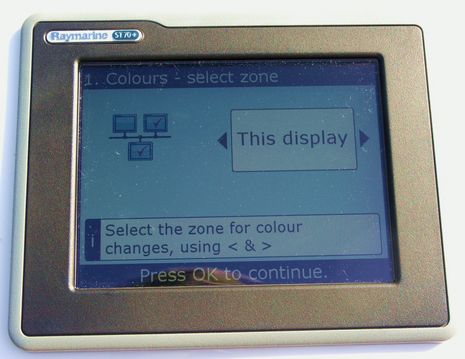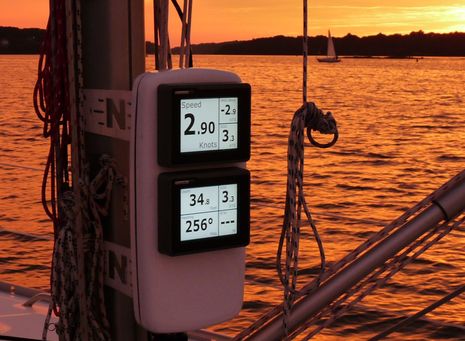Raymarine ST70 Plus, super all-in-one?
We had a peek at the ST70 Plus a while back, but I got to see them on the water in Miami, and, besides, there’s a hot conversation going on about ideal instrument displays over on the forums (warning: gobs ‘o’ geek talk). My photo — taken in glaring Florida sunshine, with on-screen crap you normally don’t notice included — doesn’t do justice to the display’s brightness, VGA resolution, and deep color saturation, but it might actually be more realistic than the glamor shots now available at Raymarine.com. The latter do, however, show many of the Plus’s display choices and color palettes. Or “Colours” as they spell it in the King’s English, and as mentioned in my shot above. Which does illustrate a bit of the system architecture I was originally confused about (and which is also explained in the now posted manuals). It seems like a flexible and powerful architecture (and hence inherently confusing), and probably a winner…
Well, given the awesome suggested prices, ST70 Pluses may at least be a winner for big, well heeled boats (though I wonder sometimes if Raymarine inflates its MSRPs for some reason). At any rate, a Plus system can be set up thusly: a single instrument keypad (or several, think wide-ass dual-helm multihull) can control any one display, or one of four groups of up to four displays, or all displays…or be dedicated to a single display or group. Of course multiple screen operations are for when you want to change things like back lighting, measurement units, or “colour” palletes; mostly you’d page through one display at a time. Smart detail: When you’re choosing single displays or groups (as in the top photo) they blink at you, so you needn’t remember which is which, let alone foul their clean design with stick-on numbers.
An ST70+ display can also be an autopilot head unit, a hell of a head unit, if you get either a sail or power pilot keypad. You have to decide if it’s a pilot or an instrument display during the install, but pilots can show some instrument info, and instruments offer pilot pages (like those seen on the ST70 pilot head, only much bigger and more detailed) but no pilot control. Pilot keypads and displays have the same flexible control nature as the instruments. Via the manuals, and from Miami, I also notice various improvements over the ST70, like the nifty and configurable racing timer below (sorry, the cannons don’t go off, but the beeper notifications sound smart). Some of these will migrate to the 70 I’m told, along with a few new N2K messages the Plus understands, like Bennett and Lenco trim tab angles.
But, like the new C-Widescreens, the Plus still can’t tell you anything about what sensors are online, let alone let you choose among them, as is seen on more modest N2K instrument displays from Simrad, Lowrance, and especially Garmin. And here’s a question: Why hasn’t Raymarine developed its own N2K sensors like the aforementioned brands? And, since it hasn’t, why doesn’t it partner with Maretron or Airmar, or both, program its displays to do their calibration, and go for it?















Never a greater contradiction in terms than “American English” English is English and Colour is Colour no need for the ” ” 🙂
Please don’t take me too seriously; I meant no harm. But, in fact, even this ST70 can be set to “US English” or “UK English” (which it obviously was). The differences aren’t major, or important, they are a hassle for programmers, editors, etc.
http://www2.gsu.edu/~wwwesl/egw/jones/spelling.htm
By the way, the ST70 Plus can alternately display Spanish, French, German, Dutch, Italian, Swedish, Danish, Norwegian, Portuguese, Russian, Finnish, Greek, Chinese, Korean, and Japanese.
“Children of a common mother, separated by a common language”…or something near that. Shaw wasn’t it?
Ben, does the ST70 plus use the same software as the ST70 ? What improvements have you seen?
A few comments have appeared on Panbo complaining about the ST70 in combination with other devices, a few days ago with the autopilot.
My experience is that the ST70 alone has been a good addition to my sailboat, and an excellent all round lead forward in display offerings.
I used it to replace an ST60 graphic that was originally installed to provide my crew feedback on boat speed as they trim the sails … but it was too difficult to see from the sides of the cockpit where the winches are.
The ST70 on the other hand is viewable from a wide angle, is viewable in direct sunlight, and is very configurable.
Why does the sail version use a keypad while the power uses a dial? What is the logic that suggests sailors do not like dials? I loved the dial on my old Cetrek autopilot and really prefered it to the keypad on my new ST70.
The software is similar but different, Dan, largely because the Plus has four times more pixels to work with. If you compare the manuals, you’ll see graphic differences, added dialog boxes, etc. “Some” of these improvements can be migrated to the ST70 and apparently will be.
It strikes me that if you are not using the SeaTalkNG/N2K features of your ST70, you’re only experiencing a fraction of its abilities. Why not build a small NMEA 2000 network with the ST70 and the Airmar Weather Station and Compass you’re testing?
At almost 8 inches wide by 6 inches high and a list price of $1750 US…….
What is the target market for this monster instrument display, Stevie Wonder’s new Mega-Yacht?
Just curious
…and the thing draws a nasty 700ma.
That’s not going on my sailboat anyways!
/j
@Russell. Sailboats use the tack function. For that you need to press simultaneously the +-1, +-10 keys. If you don’t use/need the tack function, you can install the dial version keypad in your sailboat.
r2d2, still does not make sense, a seperate tack button could be added so a dial is available to sailors as well.
One thing I hope is improved is switching between night/day palettes and brightness. On the current ST70 this is a pain, involving several menu operations (while trying to stop blinding yourself and navigating at the same time), especially when compared to the Raymarine MFDs where it is easy (though quick presets would still be an improvement on the MFDs).
A wishlist item for me would be a photodiode that automaticly switched between preset day and night settings. Its simple technology. Hmm, can the ST70 and MFDs respond to NMEA2000 instructions to change these settings? Could be a nice aftermarket product.
I just purchased a Furuno FI50 display that will give me the same information, has the photodiode for auto night/day switching, draws 1/10th the power, costs 1/3rd as much, and has a larger font than the count down timer picture above. Granted it doesn’t have a color display but I’m not into reading color books or newspapers yet either. I also agree in that I don’t see the market for this display in a modern cockpit or yacht bridge where the main nav displays are growing and squeezing out everything else.
Dave, I think the Furuno displays are excellent on many counts, particularly visibility:
https://panbo.com/archives/2008/06/n2k_instruments_in_direct_sun.html
But have you tried the set up “menus” yet? Furuno’s screen designers were harshly limited by the segmented display, good as it is in other ways.
As for the ST70 Plus, there’s no doubt those big displays are meant to mount on the masts or cockpit bulkheads of big sail boats, or on expansive yacht helms. But I bet we’ll see the concept — all-in-one N2K display with one or many separate keypads for one or many displays — made more modest for middle size vessels, by Raymarine or others.
Anything that could justify that power draw and that dinero draw would have to be megayacht big.
I like that the display has no buttons. The FI50 and IS20 have graphic and digital versions for bulkhead and mast respectively. There’s no reason you need buttons on the digital version for the mast. Buttons just add cost and take away screen real estate. You should be able to program them remotely.
Ben wrote “It strikes me that if you are not using the SeaTalkNG/N2K features of your ST70, you’re only experiencing a fraction of its abilities. Why not build a small NMEA 2000 network with the ST70 and the Airmar Weather Station and Compass you’re testing?”
–> Yes, I should do that.
Olsonist “Anything that could justify that power draw and that dinero draw would have to be megayacht big.”
—> I wonder, if in some applications this could replace three or four mast displays making the power draw more reasonable and the price attractive … and if the display can be seen from very wide angles in all lighting conditions that is a big plus. Additionaly since this can be remote controlled to switch pages so you have race start, upwind, reaching, downwind, cruise with family, etc. without using a PC … their could be a power savings … maybe even in your case ?
It is too wide for the mast. It needs to be mounted inside a Navpod for protection from spinnaker poles. This Escalade kind of thinking is common but we really want smaller lighter cheaper. The IS20s are $350 * 3.
I do like the remote control feature a lot and hopefully that will get copied in the IS20, ST70 and FI50 series.